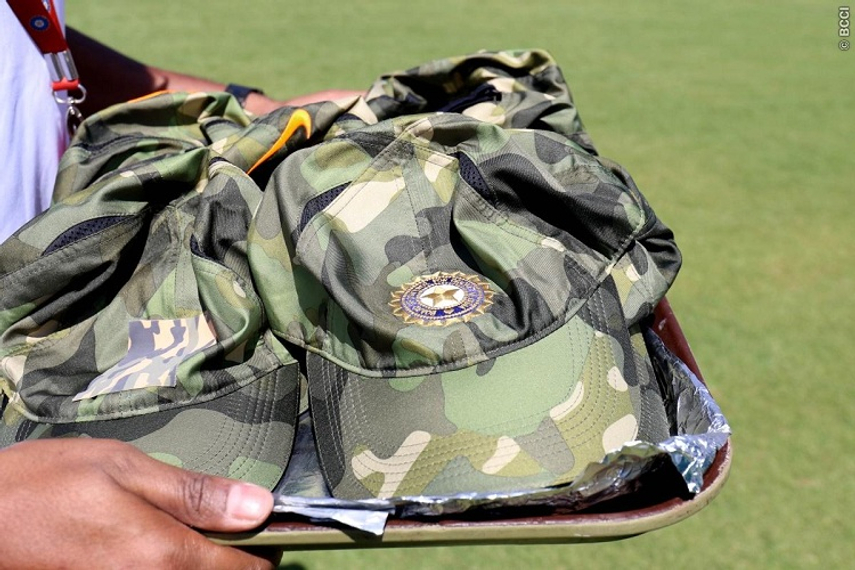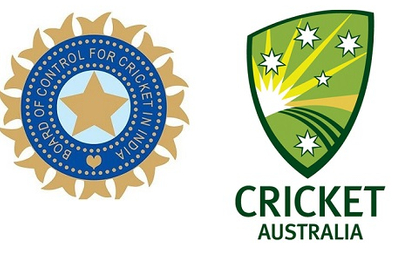
The Indian cricket team paid tribute to the soldiers killed in the Pulwama attack by wearing special camouflage caps during the India vs Australia 3rd ODI in Ranchi last week. The Board of Control for Cricket in India (BCCI) put out a tweet last Friday before the start of the match, “#TeamIndia will be sporting camouflage caps today as mark of tribute to the loss of lives in Pulwama terror attack and the armed forces and to encourage countrymen to donate to the National Defence Fund for taking care of the education of the dependents of the martyrs”. Skipper Virat Kohli appeared at the toss wearing the special cap. After winning the toss and opting to field, Kohli said: “This is a special cap, it’s a tribute to the Armed forces”.
Former Indian captain Mahendra Singh Dhoni, himself a Lieutenant Colonel of the Territorial Army (given honorary rank in November 2011), playing most likely his final game at his home ground Ranchi in the blue jersey, then proceeded to hand out the caps to other members of Team India. Not just the players, the wave of patriotism even swept the commentary box. Former India captain Sunil Gavaskar gave away the camouflage caps to Sanjay Manjrekar, Murali Karthik, Laxman Sivaramakrishnan and Harsha Bhogle. Manjrekar returned the gesture by handing a camouflage cap to Gavaskar.
On the face of it, the team donning the camouflage caps was a heart-warming gesture for sure, a raising-of-hands for solidarity, and a visible national tribute to the armed forces, especially after the 14 February Jaish-e-Mohammed terrorist attack in Pulwama that claimed 40 of our CRPF jawans. Team India also donated its entire match fees for the welfare of the martyrs’ families.
But there have been mixed signals on the tribute.
Marketer Lloyd Mathias for example, had a contrarian view. He went on record to say, “ …but I’m uncomfortable about Team India carrying a military metaphor onto a cricket field. Tribute to the Pulwama martyrs is important but a black band would have done just as well.” A lot many more cricket enthusiasts too felt that donning the military caps was a bit over the top. Good optics perhaps for nationalism but not so good for the game.
As was to be expected, Pakistan raised quite a bit of hue and cry. Taking exception to the gesture, Pakistan Foreign Minister Shah Mehmood Qureshi said the International Cricket Council must do something about it."The world saw that the Indian cricket team wore military caps instead of their own, did ICC not see this?”. Pakistan’s Information Minister Fawad Chaudhry too echoed Qureshi's sentiment. "It's just not Cricket," Chaudhry tweeted on Friday. "And if the Indian team will not be stopped, Pak cricket team should wear black bands to remind The World about Indian atrocities in Kashmir," Chaudhry wrote. The BCCI of course pooh-poohed the Pakistan objections saying prior ICC clearance had been obtained.
BCCI sources have also been quoted saying that the plan to have an Armed Forces Day had been in the pipeline for nearly six months now. The initial idea was mooted by MS Dhoni, and apparel partner Nike had been alerted to get the caps done back then. Pulwama just provided the trigger, and Ranchi was chosen as the venue in deference to Dhoni for the show of solidarity.
Symbolism and support to worthy causesis not new to cricket. In January this year, the India-Australia test at Sydney Cricket Ground was the 11th consecutive Pink Test hosted by Cricket Australia, now a tradition every year. Police at the stadium swapped their navy blue caps with pink ones, the players on both teams wore pink emblems and of course the man responsible for it all, Glenn McGrath, was decked out in a pink shirt with a candy-striped pink and blue tie. All in the memory of Jane McGrath who passed away in 2008 from breast cancer. To date the McGrath Foundation has supported over 76,000 families and funds 120 nurses. It raised US $2.1 million dollars at the Pink Test this year to fund a further 15 nurses. Cricket Australia chief Kevin Roberts did duty at the Test, and personally collected donations alongside volunteers all over and around the Sydney Cricket Ground. Indian skipper too did his bit: Virat Kohli’s gloves and pads were tinged with pink, as well as pink stickers on his MRF bat.
Pink was also the colour at New Wanderers Stadium, Johannesburg, when South Africa squared off against India in the fourth One Day International last year. First held in 2011, the Johannesburg 2018 ODI was the sixth occasion when the Proteas played a Pink ODI. Pink ODIs involve a massive drive to collect money for the Breast Cancer Clinic at the Charlotte Maxeke Johannesburg Academic Hospital and help in the treatment of cancer patients. The aim is to collect than more than Rand 1 million from the ODI and for that, not only the players but fans are also encouraged to wear pink attire to the ground. It is all pretty well orchestrated: for every boundary sponsor Bidvest donate R1000; for every catch taken Team sponsors donate R10,000; for every six hit into the Momentum Family Area, sponsors hand in R10,000.
In all fairness, the BCCI has done its bit towards showing concern for the Pulwama victims. The IPL 2019 will not have an opening ceremony this year after the Committee of Administrators (CoA) running Indian cricket decided to allocate the money set aside for it to the families of the CRPF personnel killed in the Pulwama terror attack. Last year the opening ceremony cost about Rs. 15 crore. A similar, or larger sum, will surely go to charity.
The BCCI also made quite a show of giving Jersey No.1 of the Blue Brigade to Wing Commander Abhinandan after his return from captivity in Pakistan. “#WelcomeHomeAbhinandan You rule the skies and you rule our hearts. Your courage and dignity will inspire generations to come #TeamIndia,” tweeted the BCCI handle. Captain Virat Kohli also paid rich tributes to the ‘Real Hero’. “Real Hero. I bow down to you. Jai Hind,” stated Kohli on his official twitter handle @imVkohli.
My assessment is that perhaps cricket is getting a bit too embroiled with the politics of an impending election. As Lloyd Mathias said, a black band in protest, and sympathy and solidarity, could as well have served the cause of nationalism. The camouflage cap was not really required.
Protests are largely not welcome in the spectacle of sports. It became a regular feature of the National Football League games last season for players to stage protests by “taking a knee” during the playing of the U.S. national anthem before their games. The protest escalated after President Donald Trump gave an inflammatory speech in Alabama in which he said NFL owners should “fire” any players who did not stand for the national anthem. Trump even instructed vice-president Mike Pence to walk out of a game on 8 October last year after players once again knelt during the anthem. Opinions were sharply divided on who was right, who was wrong.
The Indian cricket team in camouflage caps may not be an exact parallel but somehow it would be nice to keep the sport away from jingoism and possible politicalisation. Already the refusal of visas to Pakistani shooters has led to the International Olympic Committee suspending all Indian applications to host future events and urged international sports federations not to stage competitions in the country. BCCI on the other has tried, without visible success, to keep Pakistan out of the forthcoming World Cup by pitching the ICC. Binoo Jain in HuffPost actually makes a very interesting observation, “ … (what if) Pakistan wears its own military caps during the World Cup, will the Indian team walk of the tournament? In such a case, can Pakistan be accused of conducting a provocative act, since India showed the way?”
Jain adds, “Indian sport has had a glorious history of standing up against such jingoism and militarism. In the 1936 Berlin Olympics, India was among the handful of teams that refused to do the ‘Heil Hitler’ salute. That was also the time of heightened nationalism, though of a different sort”. I can not but agree. The caps make for good television. The caps add to the nationalistic frenzy. The caps enhance the news media decibels. But they weaken the fabric of the sport. They are a dangerous new trend that can make the sport subservient to politics. I am sure we wouldn’t want that to happen.
Think about it.
(Carol Goyal is an independent writer.)


.jpg&h=334&w=500&q=100&v=20250320&c=1)
.jpg&h=334&w=500&q=100&v=20250320&c=1)



.jpg&h=334&w=500&q=100&v=20250320&c=1)
.jpg&h=334&w=500&q=100&v=20250320&c=1)


.jpg&h=334&w=500&q=100&v=20250320&c=1)




.jpg&h=268&w=401&q=100&v=20250320&c=1)


.jpg&h=268&w=401&q=100&v=20250320&c=1)
